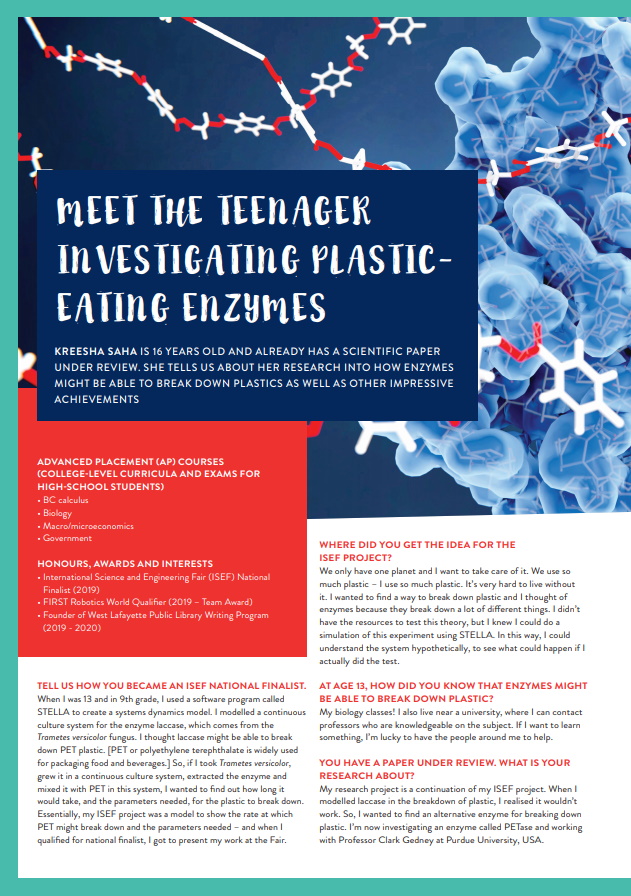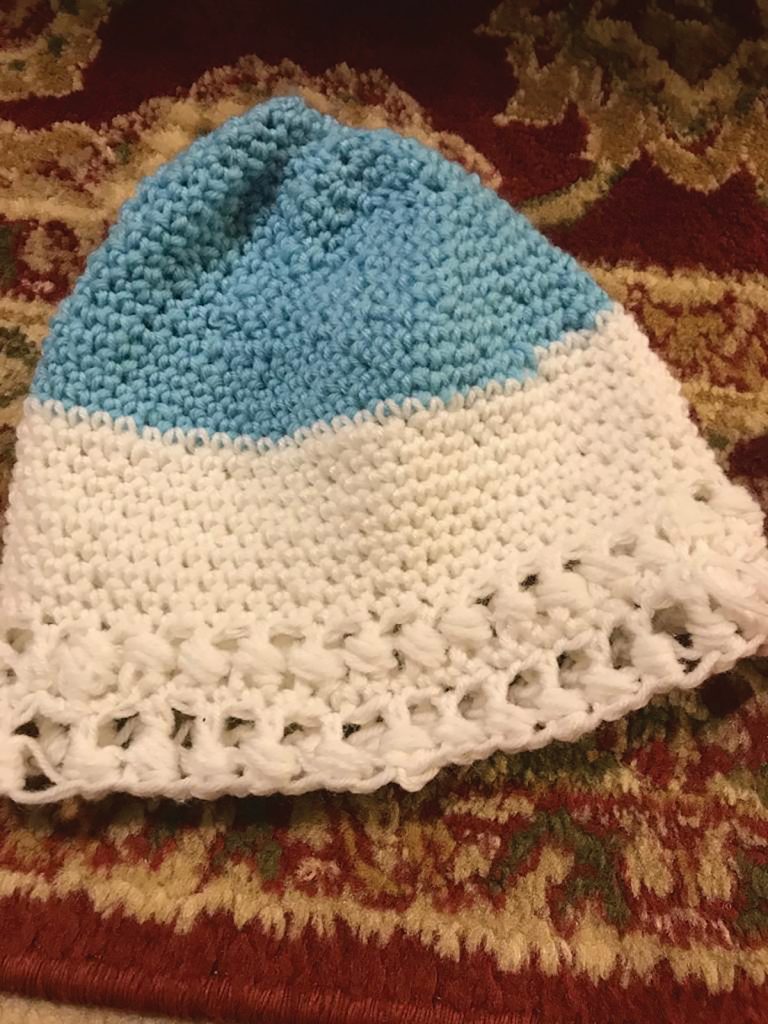Meet the teenager investigating plastic-eating enzymes
Kreesha Saha is 16 years old and already has a scientific paper under review. She tells us about her research into how enzymes might be able to break down plastics as well as her other impressive achievements
ADVANCED PLACEMENT (AP) COURSES (COLLEGE-LEVEL CURRICULA AND EXAMS FOR HIGH-SCHOOL STUDENTS)
• BC calculus
• Biology
• Macro/microeconomics
• Government
HONOURS, AWARDS AND INTERESTS
• International Science and Engineering Fair (ISEF) National Finalist (2019)
• FIRST Robotics World Qualifier (2019 – Team Award)
• Founder of West Lafayette Public Library Writing Program (2019 – 2020)
TELL US HOW YOU BECAME AN ISEF NATIONAL FINALIST.
When I was 13 and in 9th grade, I used a software program called STELLA to create a systems dynamics model. I modelled a continuous culture system for the enzyme laccase, which comes from the Trametes versicolor fungus. I thought laccase might be able to break down PET plastic. [PET or polyethylene terephthalate is widely used for packaging food and beverages.] So, if I took Trametes versicolor, grew it in a continuous culture system, extracted the enzyme and mixed it with PET in this system, I wanted to find out how long it would take, and the parameters needed, for the plastic to break down. Essentially, my ISEF project was a model to show the rate at which PET might break down and the parameters needed – and when I qualified for national finalist, I got to present my work at the Fair.
WHERE DID YOU GET THE IDEA FOR THE ISEF PROJECT?
We only have one planet and I want to take care of it. We use so much plastic – I use so much plastic. It’s very hard to live without it. I wanted to find a way to break down plastic and I thought of enzymes because they break down a lot of different things. I didn’t have the resources to test this theory, but I knew I could do a simulation of this experiment using STELLA. In this way, I could understand the system hypothetically, to see what could happen if I actually did the test.
AT AGE 13, HOW DID YOU KNOW THAT ENZYMES MIGHT BE ABLE TO BREAK DOWN PLASTIC?
My biology classes! I also live near a university, where I can contact professors who are knowledgeable on the subject. If I want to learn something, I’m lucky to have the people around me to help.
When I was 13 and in 9th grade, I used a software program called STELLA to create a systems dynamics model. I modelled a continuous culture system for the enzyme laccase, which comes from the Trametes versicolor fungus. I thought laccase might be able to break down PET plastic. [PET or polyethylene terephthalate is widely used for packaging food and beverages.] So, if I took Trametes versicolor, grew it in a continuous culture system, extracted the enzyme and mixed it with PET in this system, I wanted to find out how long it would take, and the parameters needed, for the plastic to break down. Essentially, my ISEF project was a model to show the rate at which PET might break down and the parameters needed – and when I qualified for national finalist, I got to present my work at the Fair.
WHERE DID YOU GET THE IDEA FOR THE ISEF PROJECT?
We only have one planet and I want to take care of it. We use so much plastic – I use so much plastic. It’s very hard to live without it. I wanted to find a way to break down plastic and I thought of enzymes because they break down a lot of different things. I didn’t have the resources to test this theory, but I knew I could do a simulation of this experiment using STELLA. In this way, I could understand the system hypothetically, to see what could happen if I actually did the test.
AT AGE 13, HOW DID YOU KNOW THAT ENZYMES MIGHT BE ABLE TO BREAK DOWN PLASTIC?
My biology classes! I also live near a university, where I can contact professors who are knowledgeable on the subject. If I want to learn something, I’m lucky to have the people around me to help.
YOU HAVE A PAPER UNDER REVIEW. WHAT IS YOUR RESEARCH ABOUT?
My research project is a continuation of my ISEF project. When I modelled laccase in the breakdown of plastic, I realised it wouldn’t work. So, I wanted to find an alternative enzyme for breaking down plastic. I’m now investigating an enzyme called PETase and working with Professor Clark Gedney at Purdue University, USA.
YOUR ISEF SIMULATION PROJECT SHOWED THAT LACCASE WOULD NOT WORK. WHAT OTHER CHALLENGES HAVE YOU HAD TO OVERCOME?
A challenge is that I’m inexperienced! I started this project when I was 13 and now, even though I’m taking AP biology, it’s not on par with the research I’m doing. I had to take an existing enzyme, PETase, modify it, model it, get a plasmid created by a company called IDT, insert it into E.coli, grow it, purify the protein and run reactions with it. I did have some guidance along the way, but I had to figure out a lot of it on my own – and that was difficult.
YOU ARE ALSO A FIRST ROBOTICS WORLD QUALIFIER. CAN YOU TELL US ABOUT THAT?
Every year, FIRST Robotics set a challenge, which means you have to design a robot that can do X, Y and Z, like pick up jewels from a mat or stack up foam blocks to build a wall. Your robot goes in a ring with another robot and completes various tasks. I was in 9th grade at the time and I helped program the robot, while others in our team built it using CAD (computer-aided design). We also had an outreach team, who worked on social media and getting sponsorship, etc. That was a lot of fun!
YOU ARE REALLY ANIMATED ABOUT THIS! WHAT IS IT ABOUT THIS CHALLENGE THAT YOU LIKED?
I really liked working with my team and the tasks we were being asked to do. We also had all these cool resources at our disposal, like CAD. And I liked our mentors, who were college students and very helpful.
LOOKING AT YOUR RESUME, IT IS QUITE HARD TO IMAGINE YOU DOING ANYTHING RELAXING.
I have a good social life as well as getting things done, and I like crocheting. I love fiction, music and film. I cook a lot of the food I eat. One of my dreams is to be able to have a restaurant, and to go around the world and cook stuff. I also want to learn how to tightrope walk.
DO YOU FEEL THERE IS A LOT OF PRESSURE ON YOUR GENERATION TO BE SUCCESSFUL?
I think there is a lot of pressure, yes, but for me personally, I think I perceive pressure differently to a lot of people. I do feel pressure, but I don’t take it to heart. At the end of the day, who am I going to spend the rest of my life with? Me! So, above everything else, I value what I want, what I would like to do and the way I feel. I take care of myself, listen to myself and do what I think is right for me.



